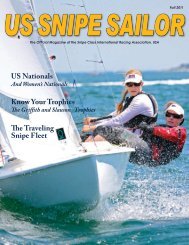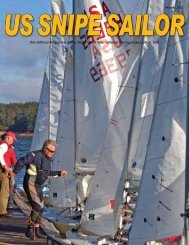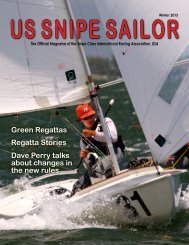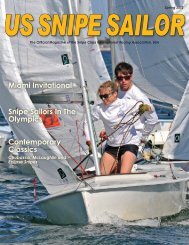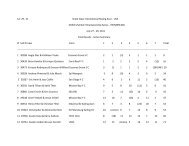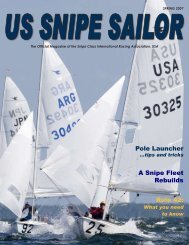Summer 2008 - United States Snipe Sailing
Summer 2008 - United States Snipe Sailing
Summer 2008 - United States Snipe Sailing
You also want an ePaper? Increase the reach of your titles
YUMPU automatically turns print PDFs into web optimized ePapers that Google loves.
Trailer Maintenance Tips<br />
Part II<br />
By John Buckley<br />
In the last issue of US <strong>Snipe</strong> Sailor, we ran an article on trailer<br />
maintenance. We received some comments and feedback on<br />
that article, and wanted to share them.<br />
One reader asked why trailer-type tires are recommended<br />
over passenger car tires. The difference is sidewall flexibility,<br />
which affects traction. Passenger vehicle tires are designed<br />
with flexible sidewalls in order to maximize the area of tread<br />
that contacts the road under various circumstances, in order to<br />
provide optimum traction. Trailers, on the other hand, simply<br />
follow along behind the tow vehicle, so traction is not an<br />
issue. In fact flexible sidewalls on trailer tires are more of a<br />
liability than an asset, since this can contribute to trailer sway<br />
– especially with heavy loads and a high center of gravity.<br />
Trailer tires have more rigid sidewalls to counteract this.<br />
On lightweight trailers carrying a single dinghy, this is not<br />
much of an issue. However, if you’re loading two, four, or<br />
even six <strong>Snipe</strong>s on a single trailer - which some people do – it<br />
adds up to a lot of axle weight and a high center of gravity. So<br />
stability is desirable.<br />
There’s a good article on this topic at http://www.<br />
taskmasterproducts.com/acatalog/whybuytrailertires.pdf<br />
Tom Townsend, of the Indianapolis Fleet, says he carries a<br />
spare wheel hub and bearings with him, packed with grease<br />
and ready to go. This is a great idea for anyone who travels<br />
extensively. He also points out that Bearing Buddies are not a<br />
panacea, and in fact they can give a false sense of confidence.<br />
He is correct – you can’t just slap them on your wheels<br />
and then forget about them. They are designed to maintain<br />
pressure in the hub, but in order for them to accomplish<br />
that, you must also have sound grease seals on the inside of<br />
your wheel hub. Properly installed and maintained, Bearing<br />
Buddies will maintain pressure indefinitely – but it’s all about<br />
the grease seals.<br />
Shortly after publishing the first article, I began renovating a<br />
trailer for someone else. It had been in storage for a long time,<br />
and we assumed it would need new bearings, grease seals,<br />
and tires. However, when it was pulled out of storage and the<br />
wheels and hubs were removed, it became apparent that the<br />
axle spindles were also damaged (see photos at right).<br />
It’s likely that what happened here was the bearings got wet<br />
and began rusting. Then, at some point, it must have sat long<br />
enough that the entire inner bearing cone rusted together.<br />
With the bearings “frozen in their tracks”, so to speak, the<br />
next attempt to move the trailer resulted in the entire inner<br />
bearing assembly rotating on the axle shaft itself – which it’s<br />
not supposed to do. Together with the fact that the grease was<br />
either gone or destroyed by moisture, the bearing assembly<br />
actually wore into the spindle (photo #1, below). The seal was<br />
damaged, and had also worn into the axle shaft.<br />
If you attempted to fix this by simply replacing the bearings<br />
and seals, the bearings would not seat properly on the spindle,<br />
and the wheel would not rotate around the center of the axle.<br />
The seal would be promptly destroyed, and you’d be right<br />
back where you started. This axle had to be replaced.<br />
Photo #1. This is the worn spindle mentioned above. (A) is the<br />
groove worn into the underside of the spindle by the bearing<br />
assembly; (B) is where the metal component of the grease seal<br />
also wore into the spindle.<br />
Photo #2. This shows an old, but unworn, axle spindle from a<br />
comparable boat trailer.<br />
US SNIPE SAILOR <strong>Summer</strong> <strong>2008</strong> 1<br />
A<br />
B



